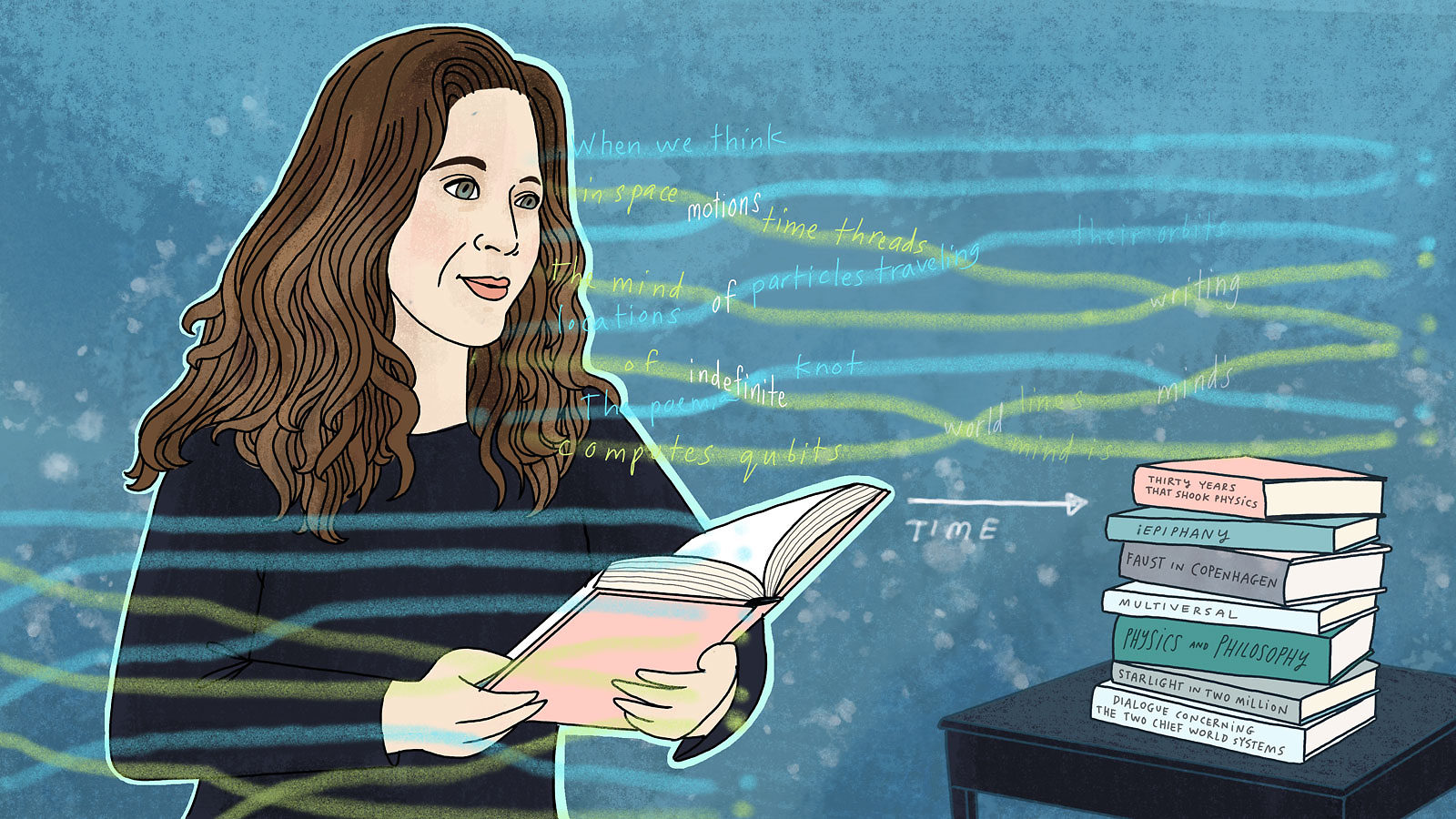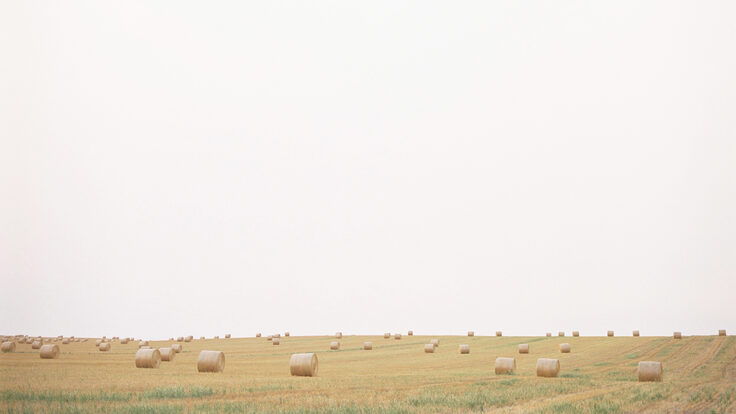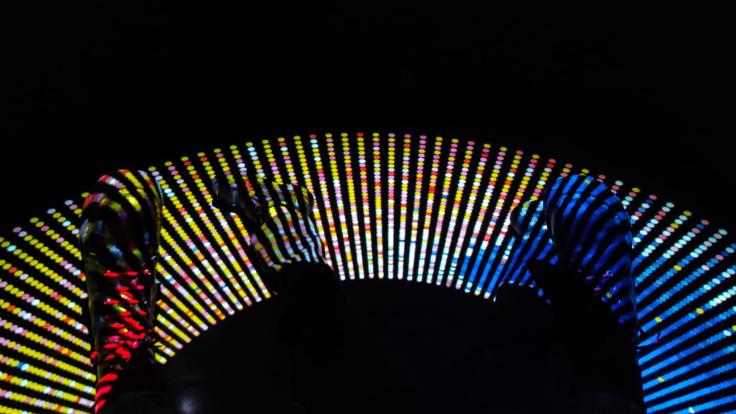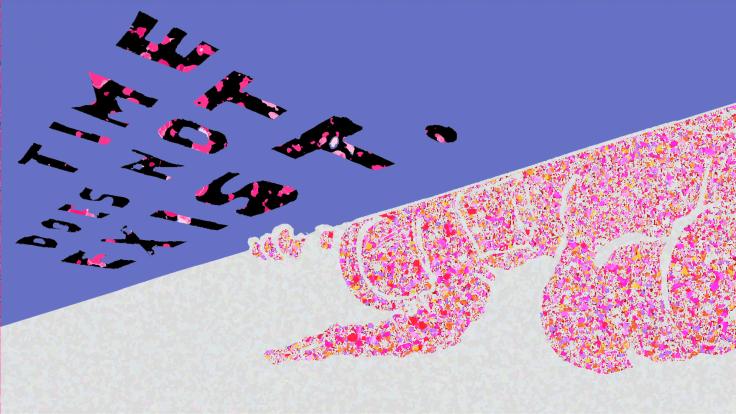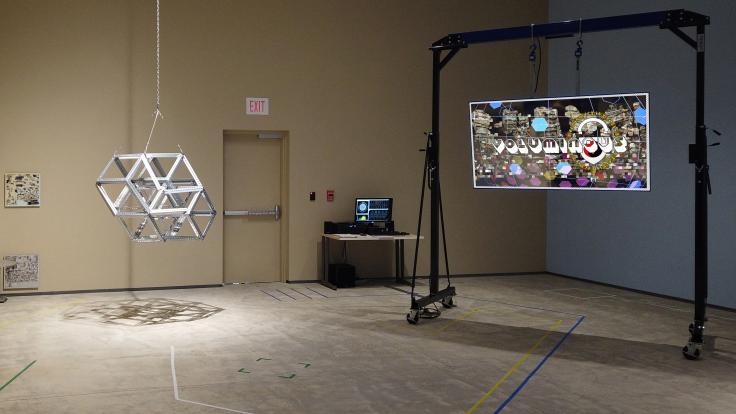In April 2018, Amy Catanzano sat in her loaned office at the Simons Center for Geometry and Physics at Stony Brook University in New York, poring over her research. The next day, she would be giving a presentation as the center’s inaugural poet-in-residence. But she wasn’t satisfied with the poems she had developed so far.
She knew the final product would be on the subject of the topological quantum computer—a type of quantum computer that scientists hope to build by “braiding” together theoretical 2D fractions of particles called quasiparticles. Catanzano had learned about topological quantum computers from Giuseppe Mussardo, a professor of theoretical physics at the International School for Advanced Studies in Italy, in October 2017 and then spent the next six months doing her own research and writing.
Despite it being the day before her presentation, Catanzano says she remained calm and focused. Years of experience had taught her to allow for spontaneous insight. “I was actively letting a creative process develop and happen on its own time,” she recalls.
Topological quantum computers may seem like an unusual interest for a poet, especially one whose last experience with formal physics education was a class in high school. But Catanzano is an unusual poet: She has developed and practices a theory of poetry called “quantum poetics” in which she explores poetry in parallel with particle physics, astrophysics and quantum theory.
An award-winning poet with a master of fine arts from the University of Iowa’s Iowa Writers’ Workshop and an associate professor of English and poet-in-residence at Wake Forest University, Catanzano began bringing science into her poetry after exploring poetry as a “philosophical investigation,” a step that she says drew her into thinking about how poems negotiate time. That brought Catanzano to physics and Albert Einstein’s theories of special relativity and general relativity.
“I always tell my students: To think like a poet, you have to follow your curiosities,” she says.
Following her own curiosities led Catanzano to a variety of readings, from stalwarts like Galileo Galilei’s Dialogue Concerning the Two Chief World Systems and Werner Heisenberg’s Physics and Philosophy, to popular science books like Gino Segrè’s Faust in Copenhagen: A Struggle for the Soul of Physics and George Gamow’s Thirty Years that Shook Physics. She even delved into textbooks, admittedly exploring the conceptual frameworks more deeply than the advanced mathematics.
Catanzano didn’t just depend on books, though. She talked to physicists at Wake Forest, exchanging ideas about poetry and science. She has even traveled to conduct research for her poetry at some of the most interesting particle physics and astrophysics sites around the world. Through grants and residency programs (like the one at the Simons Center), Catanzano has visited the Dark Energy Survey (DES) at the Cerro Tololo Inter-American Observatory in Chile, the Green Bank Telescope in West Virginia, and CERN (twice—once in 2016 as an official visitor sponsored by physicist Juan José Gómez Cadenas, and a second time in 2019 through the US ATLAS Outreach office and the Arts at CERN program).
“Poetry is not just an intellectual exercise,” she says. “The physical and artistic path to the poem influences the poem itself.”
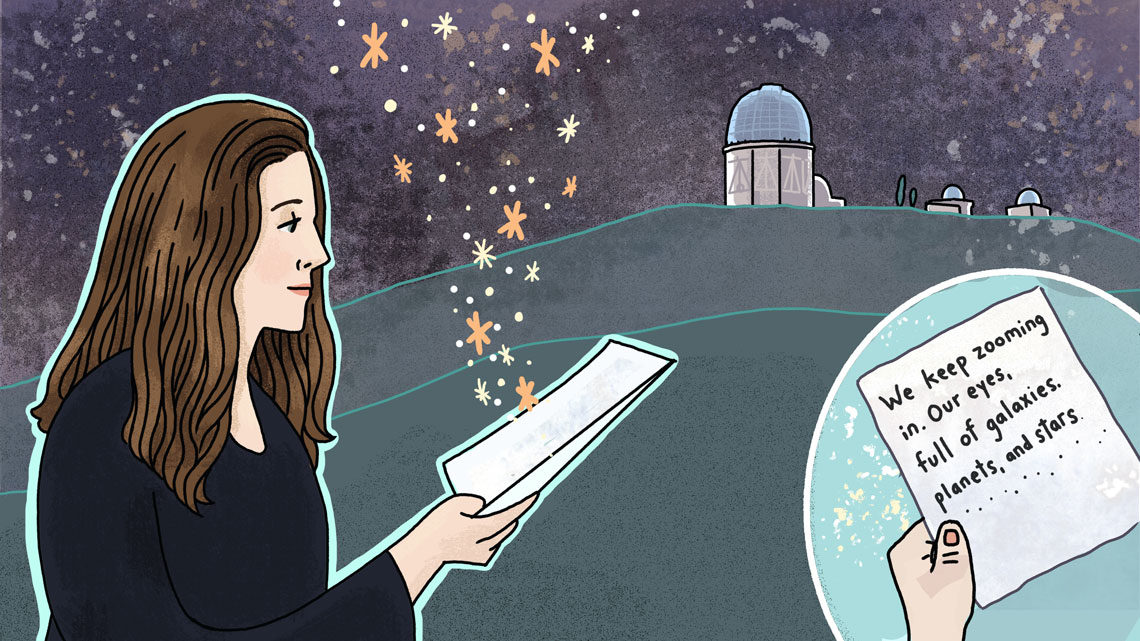
Catanzano says she conducts these visits to tour the scientific facilities and speak with scientists face-to-face. She says she loves having discussions with experts in the field; it’s a chance for her to learn more about the science while also sharing her thoughts on the relationship between poetry and science.
Although she says she believes she has a license to view the world through a poetic lens, Catanzano takes conscious steps to avoid misrepresenting the scientific concepts she writes about. While at Cerro Tololo, Catanzano worked with former DES director Josh Frieman, who advised Catanzano on the project that resulted from the trip, At the Edge of the Abyss: A Poem for the Dark Energy Survey.
Literary scholar Ming-Qian Ma—an associate professor at SUNY Buffalo who specializes in innovative poetry in relation to philosophy, science and arts—discovered Catanzano’s work when they met in a panel discussion at the Modern Language Association conference in 2012. He says he was immediately intrigued by her quantum poetics, saying it “is fundamentally different from all the other poetry theory I’ve read.”
Usually in contemporary poetry, Ma says, science is “relegated to the status of a service for poetry,” and scientific ideas, concepts and terms are “appropriated” as metaphors. But Catanzano’s poetry takes a different approach, he says. “[Hers] is an interdisciplinary practice in which both poetry and science do indeed intersect with each other, mutually engaging with each other by crossing the disciplinary boundaries and conjoining the two domains into one shared arena of experiment.”
Ma, who is not formally trained in science, has begun researching theoretical physics to better understand Catanzano’s work.
In addition to bringing literary scholars to physics, Catanzano is also getting scientists involved in her poetry—like Satya Gontcho A Gontcho, whom Catanzano met on her Cerro Tololo trip. Both an astrophysicist and a classical Indian dancer, Gontcho A Gontcho collaborated with Catanzano at a conference Catanzano convened at Wake Forest in May 2019 on the intersection of poetry, science and the arts. Gontcho A Gontcho selected parts of Catanzano’s poem that related their shared experience at Cerro Tololo, then, as Catanzano spoke the poem, Gontcho A Gontcho expressed those selections through dance.
“What I really respect about her is that she is fiercely interested in establishing a bridge between fields,” says Gontcho A Gontcho, who now works on the Dark Energy Spectroscopic Instrument at Kitt Peak National Observatory in Tucson. “To the best of her ability, [Catanzano] works to build connections between people and fields, helping us see what we already have in common.”
Both fields are attempting to describe things beyond our current understanding. In Catanzano’s words, both are capable of “reaching toward the unknown.” And both poets and scientists have their own kinds of discoveries.
Catanzano made her own discovery that day at the Simons Center. While sitting in her office and reviewing her research on topological quantum computers, Catanzano’s attention fell on the chalkboard and its multi-colored collection of chalk. She realized that she could draw the topological quantum computer model—but instead of tracing the curving lines usually used to represent the connections between quasiparticles, she would use words.
What resulted was World Lines: A Quantum Supercomputer Poem. The piece’s unconventional structure incorporates the knots, braids and so-called “world lines” of the topological quantum computing model to create a sort of “choose-your-own-adventure” poem.
“Since the reader can decide which world line to follow, and thus which version of the poem to read, the act of reading the poem performs a quantum measurement and, in the Copenhagen interpretation of quantum theory, collapses the wave function of the lines being read as that version of the poem comes into existence,” Catanzano explains in an essay published by the Simons Center.
After Catanzano’s presentation at the Simons Center, World Lines found its way into at least one unusual publication for a poem: the American Physical Society’s magazine, Physics.
Catanzano was recently granted a research leave by Wake Forest and, barring continuing travel restrictions due to the COVID-19 pandemic, has plans to conduct research at more sites later this year.
Wherever Catanzano ends up next, she hopes there’s a chalkboard close at hand.



